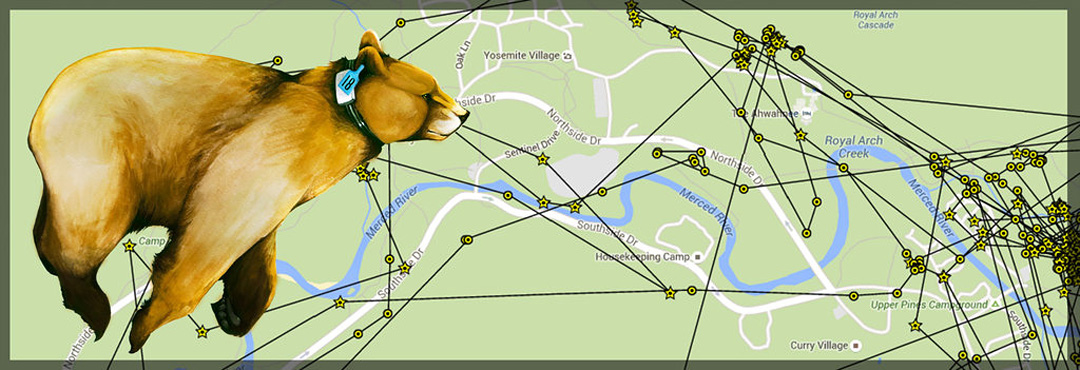
Do Yosemite Bears Hibernate?
It’s a simple fact that black bears spend their whole life following their stomachs, including in winter. Similar to the postman’s motto, “neither snow, nor rain, nor heat, nor gloom of night,” keeps a bear from eating its fill. So for bears in Yosemite, winter denning is not associated with the weather so much as it is linked to food availability. There are years when oak trees make an over-abundance of acorns, considered a mast year, and bears can been seen all winter digging under feet of snow to feast on acorns. Similarly, it has been reported in other areas that bears will rouse from winter dens to take advantage of trash cans that are put out curbside every week on trash day. So while bear behavior can be motivated by both human and unnatural foods, it is not uncommon to find bear tracks in the snow and it is important to always lock up food in a hard-sided structure or in a food locker when visiting Yosemite.

Picture taken recently from the Yosemite Museum of a bear in the snow.

Recent tracks of several bears still active in Yosemite Valley despite winter storms.
The Scoop on Bear Poop
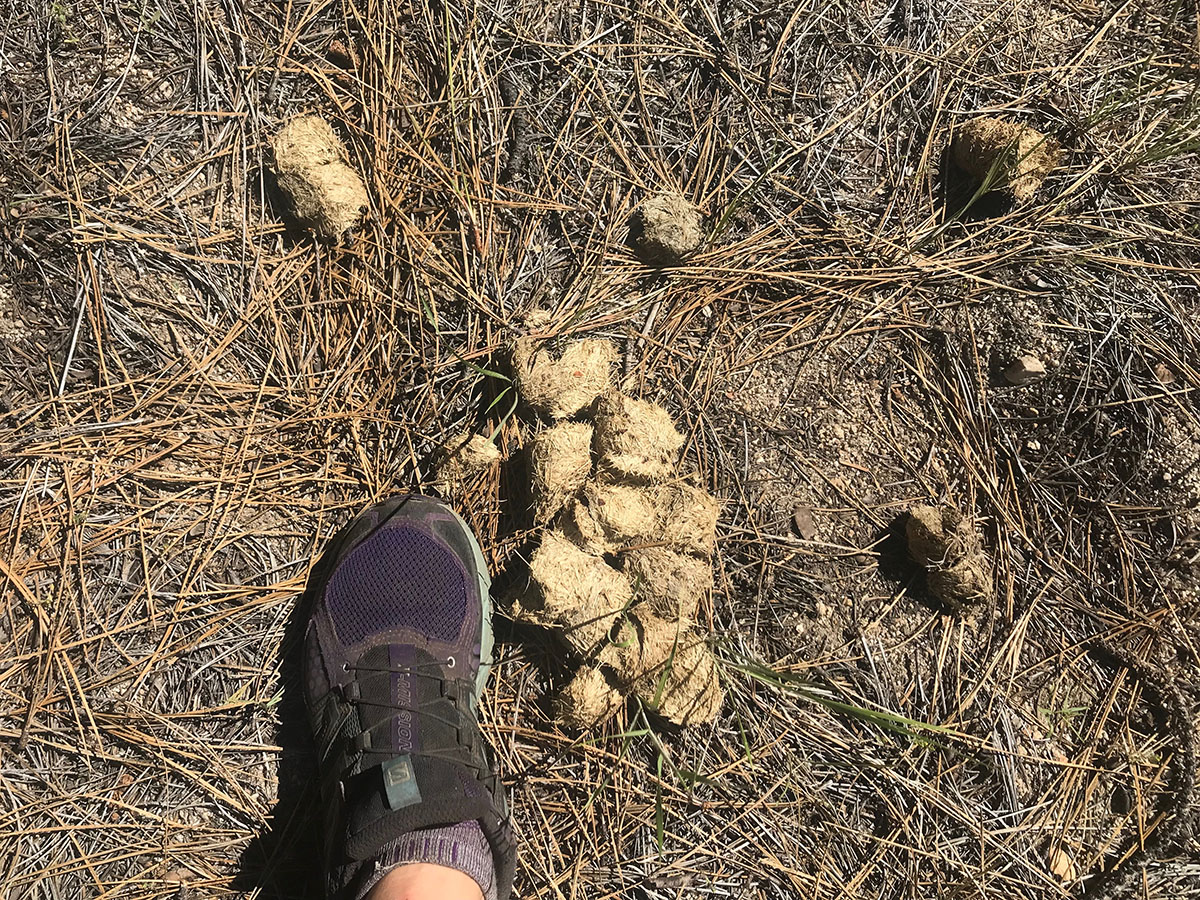
Scat (Photo: NPS)
You are walking along outside when you come upon a large pile of poop. How can you tell if it’s bear poop? Given the variation in their diets, bear scat from one bear can look very different from another bear. Poop from the same bear may look entirely different on different days. So, how can you tell?
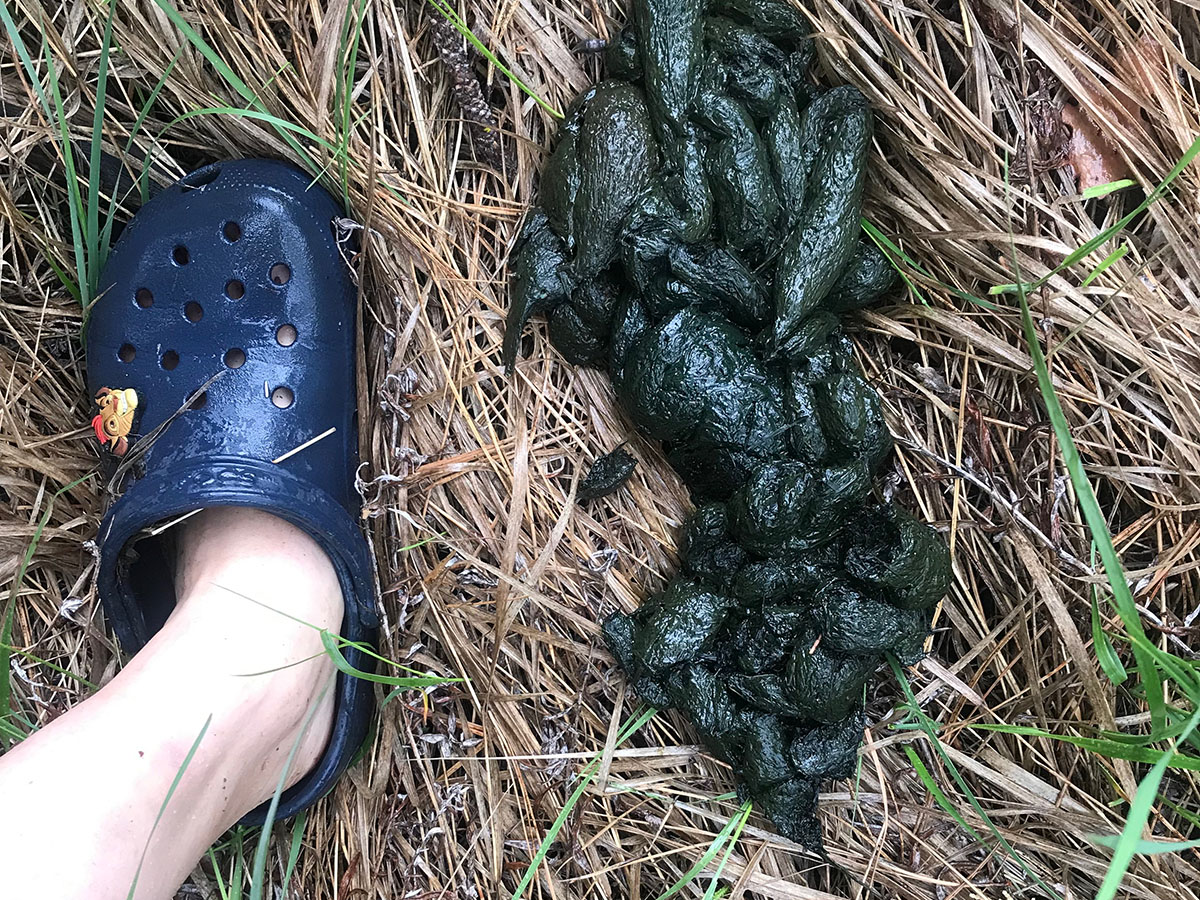
Grass scat (Photo: NPS)
Black bears are omnivores and eat a wide range of foods including grass, roots, fruit, insects, fish, and animal carcasses. Their digestive system is similar to a human’s; they have a stomach and a small and large intestine. Some things will digest in the bear’s stomach and won’t be visible in the scat, while other things, like apple peels, seeds, fur, and bones will be present in the poop. Black bear poop can take on many shapes. The color and composition of their poop will change with the seasons, as does their diet. In the spring, bears eat a lot of grass and insects, so their poop is often green and tubular, with grass visible. In the late summer and fall, bear poop will be looser and in large plops, with berries and apple pieces visible.
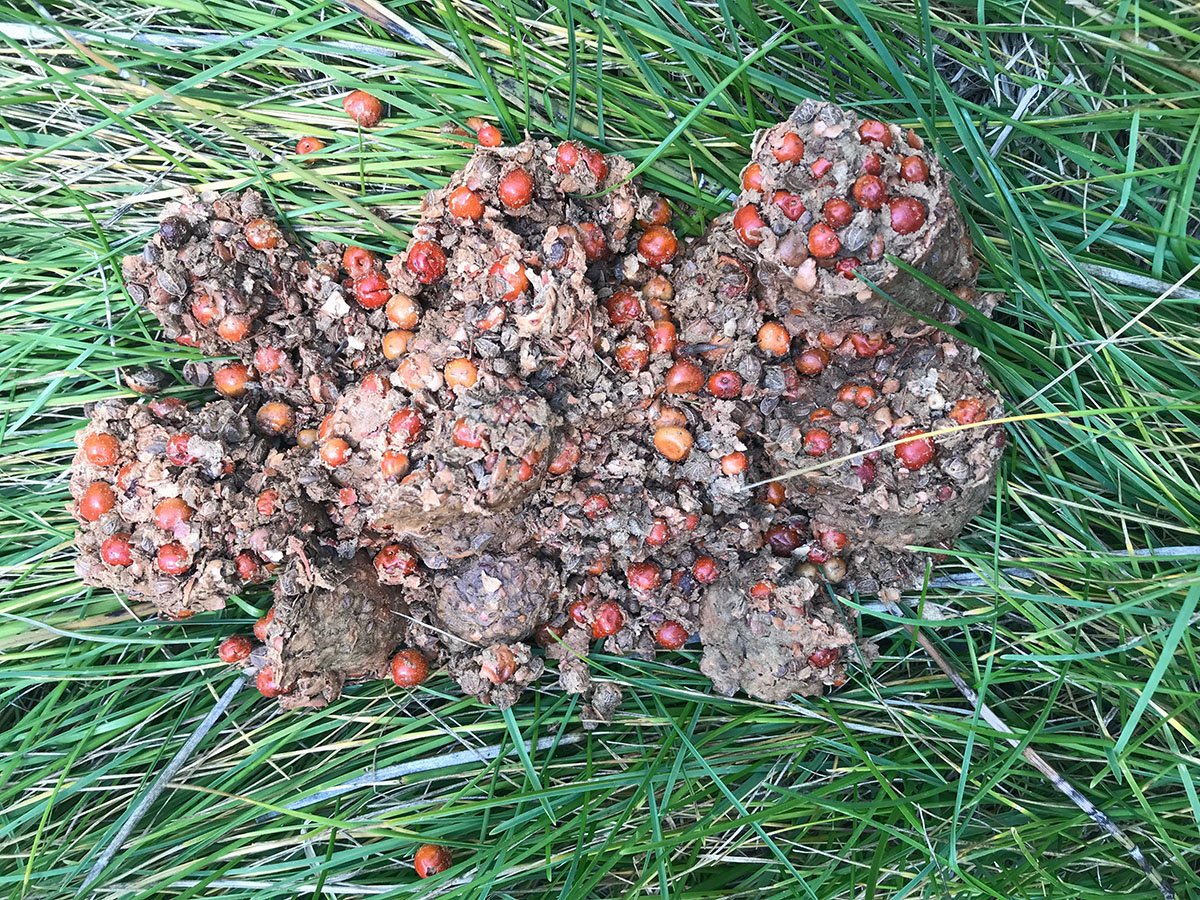
Berry scat (Photo: NPS)
What other types of poop may you come across? Here in Yosemite, you may stumble upon coyote, raccoon, mountain lion, or bobcat poop, all of which can be confused with bear poop. Coyote poop is also tubular and may contain the same foods, but it usually looks like a pile of twisted rope. Raccoons go to the bathroom in the same spot over and over, so their poops will be found in large piles called latrines. Bobcats and mountain lions both have segmented poops, a characteristic common to felines. Their poop is dense and won’t flatten if you step on it. All of the poop piles mentioned above are smaller than a bear’s.

Scat (Photo: NPS)
Well, now that you’ve got the data on the scat-a, go out and find some bear poop!
Yosemite National Park Designates Wildlife Protection Zones Throughout the Park

This image shows one of Yosemite National Park’s newly designated Wildlife Protection Zones and the associated sign that motorists will see along roadways while driving through Wildlife Protection Zones in Yosemite National Park. NPS Photo.
Speed Enforcement in Effect to Help Protect Bears and Other Wildlife
In preparation for a busy Labor Day Weekend, Yosemite National Park has designated several new Wildlife Protection Zones located on stretches of roadway throughout the Park where bears and other animals have been hit by vehicles. Visitors driving in the park this weekend will see new signs advising motorists that you are in a “Wildlife Protection Zone” and that speed limits will be strictly enforced. Multiple zones have been designated in Yosemite Valley and along sections of Big Oak Flat Road, El Portal Road, Wawona Road and Tioga Road. These zones will remain in effect until further notice.
As of August 28, 2019, 11 bears have been hit by vehicles during the 2019 calendar year. More than 400 bears have been hit by vehicles in Yosemite National Park since 1995. It’s not just bears that face the danger of being hit by a vehicle on roads within Yosemite National Park. Owls, Pacific fishers, butterflies, rare amphibians like red-legged frogs and salamanders; and mammals like deer, foxes, and mountain lions are also often hit and killed on Yosemite’s roads.
“One of the best ways to help protect wildlife in Yosemite National Park is to slow down and follow the posted speed limits within the park,” stated Yosemite National Park Superintendent Michael Reynolds. “These new Wildlife Protection Zones have been designated to help reduce the number of animals injured or killed in the park by automobiles. We thank park visitors for helping us protect Yosemite’s bears and other wildlife.”
How can park visitors help protect wildlife while driving in and around Yosemite National Park? Please stay alert, especially while driving during dawn and dusk, when animals are more active. Scan roadsides for wildlife in front of your car and obey posted speed limit signs including areas with reduced speeds. These small actions can help make a big difference and help prevent wildlife-automobile collisions.
-NPS-
Editor’s Note: The attached photo is an NPS Photo and may be published in print and electronic media. Please list the photo credit as “NPS Photo.”
Media Contacts:
Scott Gediman 209-372-0248
Jamie Richards 209-372-0529
How Old is That Bear?
One of the most common questions we get when visitors see a bear in Yosemite is, “How old is that bear?” Knowing a bear’s age can help us understand a lot about its behavior and how to manage it. If a bear has been managed since it was young, we know exactly how old it is. If bears are first captured when they are older, biologists use tooth wear as an indication of a bear’s age. Determining if the canine teeth are worn, the level of wear on the incisors, and the presence or absence of dentine spots, all place the bear into a certain age category. Bears are classified as either a cub (<1), yearling (1), sub-adult (2-3), new adult (4-7), middle-aged adult (8-15), or old adult (16+).
Bears are omnivores and eat both plants and meat, and their jaws are a combination of sharp canines and flat molars. From chewing grass, to cracking acorns, to eating carrion, a bear’s teeth are essential to their survival. As a bear ages, their teeth become worn down, rounded, and discolored.

Young bears, like yearlings, have no dentine spots. Teeth are white and canines are sharp and pointed. Photo: NPS
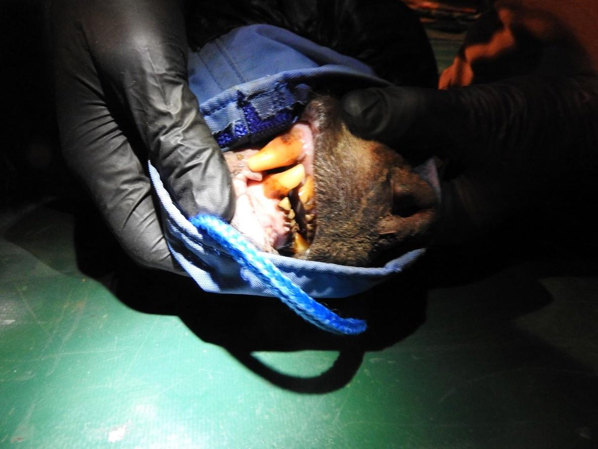
Older bears, like the this adult female captured in November 2018, have yellowing teeth and rounded canines. She is currently the oldest known tagged bear in the park at 21 years old. Photo: NPS
This bear still shows signs of good health despite her tooth wear and has been denning since December 2018. Worn teeth make it increasingly difficult for a bear to chew natural foods, and can lead to conflict with humans if a bear obtains human food that can give a bear a much easier intake of calories.
You can help us keep these and other wildlife wild and healthy by always keeping your food stored properly when in bear habitat and respecting all wildlife by keeping your distance.
How Technology Has Helped Yosemite’s Human-Bear Management Program Hit All-Time Low Bear Incidents

Photo: Josh Helling
Yosemite has a long and tedious history managing bears, people, and the interactions between the two. In 1998, the park hit a record high number of bear incidents in the park with over 1,500 (documented) incidents in one year. This was a huge turning point for the park in changing the way that we managed our bears, and more importantly, people. Beginning in 1999, massive efforts to provide public information and education regarding bears and food storage, along with improvements to the park’s bear-resistant food storage and garbage disposal infrastructure greatly reduced availability of human foods to bears and educated millions of visitors. Additionally, individual bears were managed more directly/rapidly with an intensive program to scare them away from development using anything from yelling to less-than-lethal shotgun rounds. These efforts resulted in quick and major improvements to human-bear conflict. But still, the number of bear incidents remained in the hundreds each year for well over a decade.

With the use of technology, incidents have now been under one hundred per year for over four years. This year we’ve hit a new record low, with only about 22 bear incidents total for 2018. If you want to learn more about how the park used technology to further reduce bear incidents, you are in luck! There is a new journal article out describing how technology was used in Yosemite’s Human-Bear Management Program to bring the number of human-bear conflicts in the park to new record lows.
Mazur, Rachel L.; Leahy, Ryan M.; Lee-Roney, Caitlin J.; and Patrick, Kathleen E. (2018) “Using Global Positioning System Technology to Manage Human-Black Bear Incidents at Yosemite National Park,” Human–Wildlife Interactions: Vol. 12 : Iss. 3 , Article 8.
Available for download at: https://digitalcommons.usu.edu/hwi/vol12/iss3/8
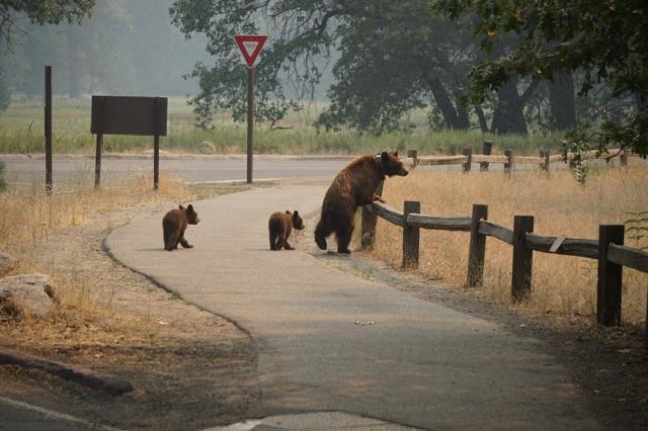
Empty Yosemite – Bears Take Back Yosemite Valley During the Ferguson Fire
On July 13, 2018, the Ferguson Fire started in the Merced River Canyon just west of Yosemite National Park. At the time the fire started, the park was experiencing peak season visitation and biologists were monitoring up to 20 different bears foraging naturally in Yosemite Valley on a daily basis. Yosemite Valley and some other areas closed to visitors from July 25 to August 14 due to health and safety concerns. Employees and residents were also evacuated for part of that time, leaving only firefighters and emergency personnel behind. Consequently, Yosemite Valley was unusually empty and exceptionally quiet. As a result, bears immediately began frequenting many areas normally teeming with people during bustling summer days.
Black bears are naturally curious, but shy away from people. They generally use corridors of forest cover to make loops around their home ranges in Yosemite Valley while searching for food. As opportunistic omnivores, they prefer food sources that are readily accessible and away from busy human developments. Even food conditioned bears prefer to use the cover of night and forest to enter heavily populated areas.
During the closure of Yosemite Valley, bears spent more time in developed areas in search of natural food sources. In the absence of park visitors, they boldly crossed roads, bike paths, and walked through empty campgrounds, parking lots, and through other areas that are typically swarming with people. Bears took advantage of the historic apple orchards, gorging themselves on apples. The Majestic Yosemite Hotel (formerly The Ahwahnee) lawn, usually filled with visitors picnicking , wedding parties and kids playing was now instead the location two male bears chose to play together, grazing on the grounds.

Bear at the Majestic Yosemite Hotel (Photo: Dakota Snider)
This behavior gives biologists a glimpse into a more wild Yosemite Valley when it was only sparsely populated and much less visited. A time when black bears and other wildlife were able to chose the path of least resistance, instead of the path of least population to obtain natural food sources such as fruits, insects, acorns, and grasses.

GPS tracks showing bears in Yosemite Valley during the Ferguson Fire
Hungry Fall Bears – Residents Beware!
During fall, in preparation for hibernation, bears eat up to 20,000 calories every day. That’s like eating nine large cheese pizzas, about 35 medium bean and cheese burritos, or 93 Snickers bars every single day! In terms of a bear’s natural diet, that’s equal to over 11 pounds of acorns or around 100 pounds of berries.
Bears looking for food, particularly this time of year, can be attracted to residential areas by many natural food sources (acorns, fruit, wasp nests) and if residents’ food and/or attractants are not properly stored, they’ll take advantage of that, too. Bears exposed to human food, or just used to being in residential areas, can quickly become food conditioned (meaning they’ve learned to associate people or development with food), or habituated (in which they lose their natural fear of people, often getting dangerously close to people or homes). They may even start entering homes for food, which can quickly become dangerous for residents and bears alike. Simple things like keeping windows and doors closed and latched, properly disposing of trash and recycling, not using bird feeders (these also are great bear feeders), and cleaning barbeque grills each time you use it, can do a long way in protecting bears if you live in bear habitat.
In October, one thing many people don’t consider when living in (or visiting) bear habitat, is that pumpkins are not only one of our favorite Halloween decorations, but they are also food. In Yosemite we’ve seen bears eat pumpkins in neighborhoods numerous times, and so we ask that people keep them inside except for during active trick or treating. We also remind residents never to leave candy out on their porches…a treat too tempting for a bear to walk past.
Troublesome Teens – Yearling Bears in Yosemite
Summer is upon us! The days are longer, the weather is warmer, and the kids are finally out of school and ready to explore their new-found freedom; and in a similar capacity, so are the young black bears of Yosemite. The transition from spring to summer is a coming-of-age time in the lives of young yearling black bears, when they are forced to leave their mothers’ sides and begin life on their own. These yearling bears set off on their own in May and June after spending a full year with their mother learning the way of the woods. However, they are still naïve and extremely curious, making this a crucial window for their behavioral development and the focus of many management efforts as they try to find their place in the world during these early summer months.
 In their first year of life, black bear cubs learn and grow under the watchful eye of their mother. They learn foraging habits and feed off of the sow’s extremely nutrient-dense and fatty milk, rapidly taking on weight. A year passes before the mother stops providing for her now 40-to-80-pound offspring, and instead chases it off. The sow will do this (often repeatedly) to send a message to her offspring that their free ride is up and it is time for them to be self-reliant. This is mainly triggered by the energy demands of the rapidly growing yearling, which outpaces the sow’s ability to provide for it, along with her own need to put on weight and a budding interest in reproducing again.
In their first year of life, black bear cubs learn and grow under the watchful eye of their mother. They learn foraging habits and feed off of the sow’s extremely nutrient-dense and fatty milk, rapidly taking on weight. A year passes before the mother stops providing for her now 40-to-80-pound offspring, and instead chases it off. The sow will do this (often repeatedly) to send a message to her offspring that their free ride is up and it is time for them to be self-reliant. This is mainly triggered by the energy demands of the rapidly growing yearling, which outpaces the sow’s ability to provide for it, along with her own need to put on weight and a budding interest in reproducing again.
These yearling bears are well prepared for life and capable of beginning on their own. However, they’ll need to establish their own home range and find their own food sources without the helpful guidance and added security they previously had with their mother. It takes a bit of time and a lot of and exploring from an already innately curious creature, which can get them into trouble if they find themselves in campgrounds or around other human populated areas.
The majority of bear reports in Yosemite in the last month have been from yearling bears in and around campgrounds. What seems like an innocent pass-through of these campgrounds (or any other human populated area for that matter) can be detrimental to their development if met with a human food reward or increased comfort around people. While these yearlings venture out for new territory and food sources, they are constantly learning and picking up habits (both good and bad) that will stick with them for life, making them extremely vulnerable to becoming habituated and food conditioned. If a bear gets human food in a campground, from a backpack, a cooler, or even overflowing trash, it creates a nearly irreversible learned behavior for that bear to associate these objects and areas as potential food sources. At that point, a bear might alter its normal foraging behavior and spend some of its time opportunistically searching for human food, beginning a downward spiral in behavior.
 Many of our management efforts are aimed at preventing these bears from ever getting to the point of becoming habituated and/or food conditioned due to human negligence, but it is not always enough. With the amount of visitation Yosemite receives, the margin for human error is small, so each year bears obtain human food and become habituated and/or food conditioned. At that point, our next response is a tireless effort of extensive monitoring and negative conditioning routine of these bears whenever they exhibit these behaviors, in hopes of returning these bears to their wild ways. Patrols can turn into all-night affairs in an attempt to remove human food from their diet. The quicker we can intervene the better, which is why it’s critical to report all bear sightings to the Yosemite Bear Hotline at 209/372-0322.
Many of our management efforts are aimed at preventing these bears from ever getting to the point of becoming habituated and/or food conditioned due to human negligence, but it is not always enough. With the amount of visitation Yosemite receives, the margin for human error is small, so each year bears obtain human food and become habituated and/or food conditioned. At that point, our next response is a tireless effort of extensive monitoring and negative conditioning routine of these bears whenever they exhibit these behaviors, in hopes of returning these bears to their wild ways. Patrols can turn into all-night affairs in an attempt to remove human food from their diet. The quicker we can intervene the better, which is why it’s critical to report all bear sightings to the Yosemite Bear Hotline at 209/372-0322.
It’s hard to express just how heartbreaking it is to see a wild Yosemite bear, especially so early on in its life, begin down a path to habituation and food conditioning. What was once a wild and self-reliant bear becomes a sad symbol of the mark we as man have on nature. However, through proper food storage, keeping our distance, educating people, and respecting wild animals can we lessen the impact we are having on Yosemite bears and continue to coexist with these charismatic creatures.
Bears and the Bees

Bears seen right before mating occurred (Photo: Andi Stewart)
Spring is transitioning into summer and mating season in Yosemite has begun! Bears are solitary creatures and aren’t often seen in pairs or sloths (a group of bears is called a sloth). However, there are a few common exceptions: when food is overly abundant in one specific place, when sows have cubs or yearlings, and in the late spring and early summer during mating season (May–July).
Bears generally become reproductively mature between the ages of 3 and 5 years old. Bears are polygamous, so it is common for an individual bear (of either sex) to mate with multiple bears within one mating season. A female bear may give birth to cubs with different fathers in the same litter. Male bears will court females with a variety of behaviors, including barking, biting, hugging, mock fighting, and kissing. This behavior can take between a couple hours up to a couple days.
Even though bears mate and eggs are fertilized in the spring/summer, embryonic growth will not occur until fall. This is because bears use a clever reproductive strategy called delayed implantation. This allows for bears to only have the number of cubs that their bodies are able to support over the winter. if they have a lot of fat stored in the fall, they are likely to have more cubs than if they are thin. On average, a bear will have a litter of two cubs, but a very well fed bear could have three or more! Likewise, a thin bear may only have one cub, or none that year. Cubs are born between January and February weighing less than a pound.
Females mate and have cubs every other year. Their cubs stay with them through their second spring, when it is time for the sow to mate again. This is when the one-year-old bears (yearlings) will go off on their own. These yearlings are often mistaken for cubs who are missing their mother. They are generally between 50 and 80 pounds and are trying to find their place in the landscape. Female yearlings are less likely to disperse than males, often having overlapping home ranges with their mother even into adulthood.
It is very important to always keep a safe distance from all wildlife in Yosemite National Park (a minimum of 50 yards from any bear). Mating bears can exhibit unusual behaviors and males may become more aggressive. Females with cubs can be protective of their young, and yearlings out on their own for the first time have a particularly hard time staying out of trouble with humans. It is crucial that they keep their natural fear of humans, and never learn about human food, so that they can remain wild. This is an exciting time to see bears exhibiting wild behaviors, but please, for your safety and theirs, always protect your food from wildlife and never approach wild animals, even if it means giving up on that perfect photo opportunity.
Bears Like Trails Too!
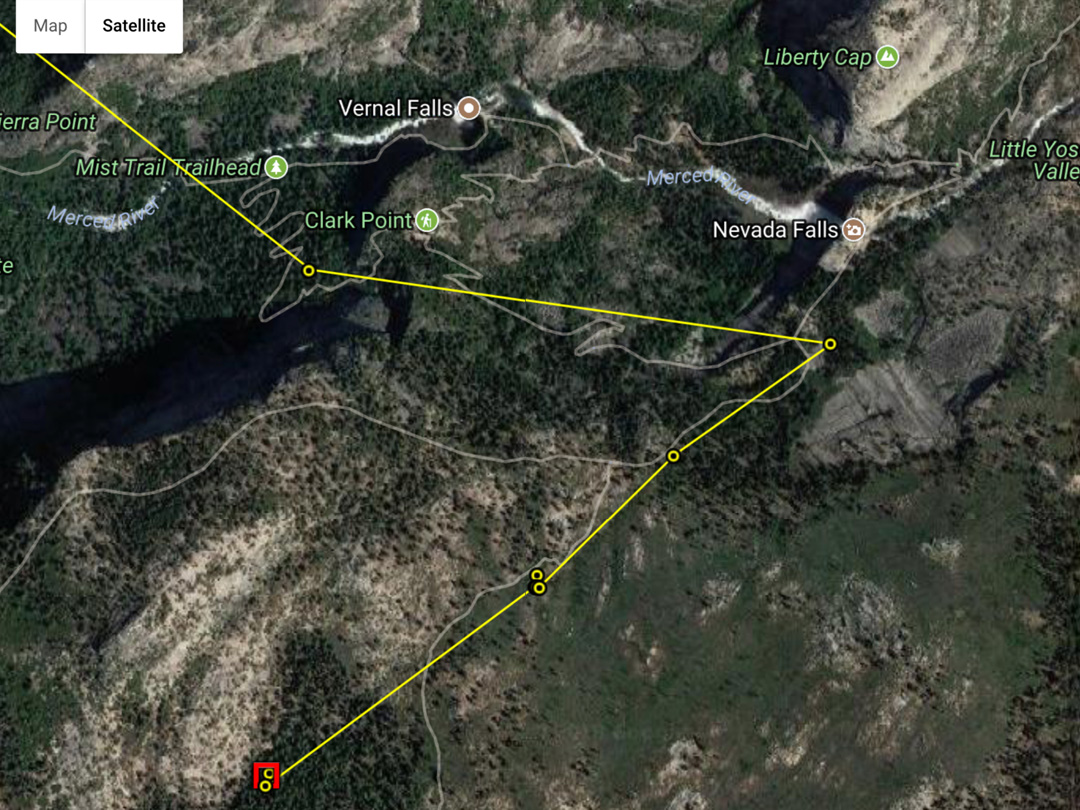
Trails make getting through the rugged Yosemite wilderness easier for bears and humans alike. This GPS track shows an adult male bear that decided to follow a few of the scenic trails leading out of Yosemite Valley one day in the summer of 2014. Yosemite’s trails traverse much of the park, and humans and bears often agree on the best trailside rest stops, access to water, and cozy campsites. Unfortunately, this also means that bears can learn to associate busy trails with opportunities to find dropped food, unattended packs, and even beg for handouts. While it’s not necessarily common to stumble upon a bear while hiking, there are a few things people can do to help wildlife.
Wild bears naturally avoid human activity, but as a they spend time in the presence of people without experiencing negative consequences they may quickly become habituated. When bears become habituated to human presence, they lose their natural instinct to fear or avoid people and are more likely to spend time along popular trails. As bears learn to move comfortably in busy human environments, their opportunistic nature inevitably leads to conflict. A bear that spends significant time around people is much more likely to find an unattended backpack, open bear canister, or food trash. The first time a bear obtains high-calorie human food, it can quickly become food conditioned and preferentially seek out areas of human activity in search of it. This behavior often results in escalating conflicts where wildlife managers are forced to intervene; oftentimes on crowded trails or in remote wilderness locations.

With the privilege of hiking in the stunning Sierra Nevada mountains comes the importance of learning trail etiquette, including appropriate behavior around black bears. Day hikers and backpackers in Yosemite have the responsibility to stay within arm’s reach of their food while hiking by never leaving their backpack unattended or walking away from their food while picnicking. Anyone staying overnight in the park’s wilderness needs to carry an allowed bear-resistant food container to keep bears and other wildlife from accesing its contents (and so that a backpacker won’t lose all their food to a bear). It is important to give wildlife space (at least 50 yards for a bear), even if that means waiting for a bear to move off a trail before proceeding. Surrounding a bear on a trail may force the animal into close proximity to humans, block its escape routes, and/or create a dangerous situation for both people and the bear. If you encounter a bear on the trail, give the animal plenty of space and protect your food. Keep it with you. Do not abandon it, or throw it to the bear as a distraction. If the bear approaches you, a campsite, or is attempting to eat human food, gather together and yell, “Get out of here, bear!” as loudly as possible. Report all bear sightings to Yosemite’s Bear Hotline at 209-372-0322.
Although particular bears may seek out easy high-calorie human food, natural food sources are plentiful for the well-adapted American black bear. They do not need our food to survive, rather the opposite. They need to avoid our food in order to maintain their natural bear behaviors, and avoid conflict with people. Grasses, insects, berries, and acorns provide ample food for bears in wilderness. Remember, the ONLY help they need from us is respect and distance!
